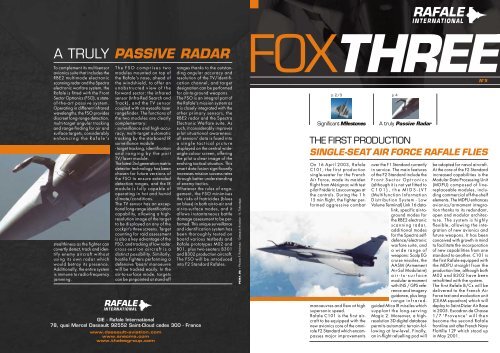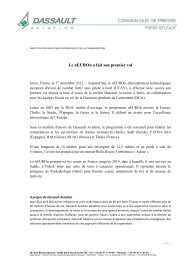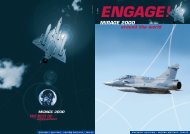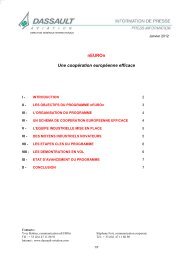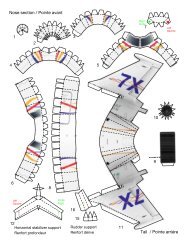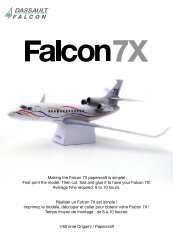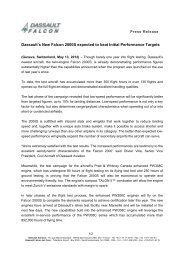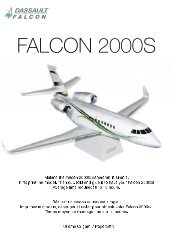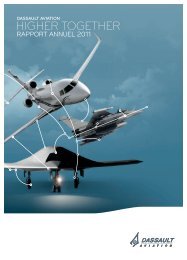You also want an ePaper? Increase the reach of your titles
YUMPU automatically turns print PDFs into web optimized ePapers that Google loves.
A TRULY PASSIVE RADARTo complement its multisensoravionics suite that includes theRBE2 multimode electronicscanning radar and the Spectraelectronic warfare system, theRafale is fitted with the FrontSector Optronics (FSO), a stateof-the-artpassive system.Operating in different infraredwavelengths, the FSO providesdiscreet long-range detection,multi-target angular trackingand range-finding for air andsurface targets, considerablyenhancing the Rafale'sstealthiness as the fighter cancovertly detect, track and identifyenemy aircraft withoutusing its own radar whichwould betray its presence.Additionally, the entire systemis immune to radio-frequencyjamming.The FSO comprises twomodules mounted on top ofthe Rafale's nose, ahead ofthe windshield, to offer anunobstructed view of theforward sector: the infraredsensor (Infra-Red Search andTrack), and the TV sensorcoupled with an eyesafe laserrangefinder. The functions ofthe two modules are clearlycomplementary:- surveillance and high-accuracy,multi-target automatictracking by the starboard IRsurveillance module- target tracking, identificationand ranging by the portTV/laser module.The latest 3rd generation matrixdetector technology has beenchosen for future versions ofthe FSO to ensure extendeddetection ranges, and the IRmodule is fully capable ofoperating in hot and humidclimate/conditions.The TV sensor has an exceptionallong-range identificationcapability, allowing a highresolutionimage of the targetto be displayed on any of thecockpit's three screens. Targetcounting for raid assessmentis also a key advantage of theFSO, and tracking of low radarcross-section aircraft is adistinct possibility. Similarly,hostile fighters performing adefensive 'beam' manoeuvrewill be tracked easily. In theair-to-surface mode, targetscan be pinpointed at stand-offGIE - Rafale International78, quai Marcel <strong>Dassault</strong> 92552 Saint-Cloud cedex 300 - Francewww.dassault-aviation.comwww.snecma.comwww.thalesgroup.comranges thanks to the outstandingangular accuracy andresolution of the TV/identificationchannel, and targetdesignation can be performedfor air-to-ground weapons.The FSO is an integral part ofthe Rafale's mission system asit is closely integrated with theother primary sensors, theRBE2 radar and the SpectraElectronic Warfare suite. Assuch, it considerably improvespilot situational awareness:all sensors' data is fused intoa single tactical picturedisplayed on the central wideanglecolour screen, offeringthe pilot a clear image of theevolving tactical situation. Thissmart data fusion significantlyincreases mission success ratesthrough better understandingof enemy tactics.Whatever the rules of engagement,the FSO minimisesthe risks of fratricides (blueson blues) in both air-to-air andair-to-surface modes, and itallows instantaneous battledamage assessment to be performed.This unique surveillanceand identification system hasbeen thoroughly tested onboard various testbeds andRafale prototypes M02 andB01, plus two-seaters B301and B302 production aircraft.The FSO will be introducedinto F2 Standard Rafales.PEMA 2b - Photos F. Robineau - <strong>Dassault</strong> <strong>Aviation</strong> - K. Tokunaga.FOXTHREEN°5p.2/3 p.4Significant MilestonesTHE FIRST PRODUCTIONSINGLE-SEAT AIR FORCE RAFALE FLIESOn 16 April 2003, RafaleC101, the first productionsingle-seater for the FrenchAir Force, made its maidenflight from Mérignac with testpilot Frédéric Lascourreges atthe controls. During the 1 h15 min flight, the fighter performedaggressive combatmanoeuvres and flew at highsupersonic speed.Rafale C101 is the first aircraftto be equipped with thenew avionics core of the omniroleF2 Standard which encompassesmajor improvementsA truly Passive Radarover the F1 Standard currentlyin service. The main featuresof the F2 Standard include theFront Sector Optronics(although it is not yet fitted toC101), the MIDS-LVT(Multifunction InformationDistribution System - LowVolume Terminal) Link 16 datalink,specific air-togroundmodes forthe RBE2 electronicscanning radar,additional modesfor the Spectra selfdefence/electronicwarfare suite, anda wide range ofweapons: Scalp EGcruise missiles, theAASM (ArmementAir-Sol Modulaire)air-to-surfacemodular armamentwith INS / GPS referenceand imageryguidance, plus longrangeinfraredguidedMica IR missiles whichsupplant the long-servingMagic 2. Moreover, a highresolution3D digital databasepermits automatic terrain-followingat low-level. Finally,an in-flight refuelling pod willbe adopted for naval aircraft.At the core of the F2 Standardincreased capabilities is theModular Data Processing Unit(MDPU) composed of linereplaceablemodules, includingcommercial off-the-shelfelements. The MDPU enhancesavionics/armament integrationthanks to its redundant,open and modular architecture.The system is highlyflexible, allowing the integrationof new avionics andfuture weapons. It has beenconceived with growth in mindto facilitate the incorporationof new capabilities from onestandard to another. C101 isthe first Rafale equipped withthe MDPU straight from theproduction line, although bothM02 and B302 have beenretrofitted with the system.The first Rafale B/Cs will bedelivered to the French AirForce test and evaluation unit(CEAM squadron) which willdeploy to Saint-Dizier Air Basein 2005. Escadron de Chasse1/7 'Provence' will thenbecome the second Rafalefront-line unit after French NavyFlottille 12F which stood upin May 2001.
SIGNIFICANTMILESTONESIn the last few months, the Rafale has passed numerous and significant milestonesin its development programme. The trials of the air-defence Standard F1have been completed, and various new configurations have been tested withStandard F2 and F3 external loads. New internal and external systems are also underactive development and testing.New external loadsThe range of missions which canbe performed by the Rafale isconstantly being expanded, andthe integration and trials of theIntertechnique buddy-buddy refuellingpod have now been completed.This pod is due to be usedby the French Navy from its aircraft-carrierto provide an organicin-flight refuelling capability tothe carrier battle group. "To date,Rafale M1, the first productionnaval Rafale, has successfullyrefuelled other Rafale and SuperEtendard fighters, clearly demonstratingthe inherent flexibility ofthe design, explains Pierre-CyrilDelanglade. The pod itself hasbeen cleared up to Mach 0.9 /580 knots IAS, and in-flight refuellingshave been conducted - withtransfer rates of 530 litres/minute- at 280-350 knots at altitudes upto 20,000 feet, but this could beexpanded to 30,000 feet withoutany problem." Even for countrieswith no naval air arms, a Rafaleequipped with this refuelling podcould increase the combat capabilitiesof a strike package as itboasts a significant self-escortcapability with its Mica air-to-airmissiles, allowing a raid to penetratedeep into hostile territorywhile still having an embeddedtanker force.Similarly, the Rafale has successfullyflown with a NewGeneration Reconnaissance Pod(NG Recce Pod), a new configurationwhich is representative ofthe Standard F3 fighter. The NG"At the moment, we are concentratingon the trials of the F2 omnirolestandard, says Pierre-CyrilDelanglade, Engineer in Chargeof Rafale Flight Tests at Istres. Weare busy expanding the flightenvelope with new external storesin heavy configurations. We arealso performing weapons releasesto make sure there are no adverseeffects on the stores or on the aircraftduring the release."Internal systems trials have followeda similar path, and progresshas been quick: <strong>Dassault</strong><strong>Aviation</strong> test pilots and flight testengineers have been very activedeveloping and testing the FrontSector Optronics (FSO), the Link16 Multifunction InformationDistribution System-Low VolumeTerminal (MIDS-LVT) datalink, theModular Data Processing Unit(MDPU), and the Direct VoiceInput system.Recce Pod will significantly boostthe capabilities of reconnaissanceunits. It will be fielded by Rafaleunits from 2007, and will progressivelysupplant Mirage F1CRand Super Etendard reconnaissanceaircraft currently in servicewith the French Air Force andNavy. The NG Recce Pod hasbeen flown at Mach 0.9 / 580knots IAS with two 2,000 litreexternal fuel tanks and four Micamissiles. Supersonic speeds havebeen demonstrated too, the fighterreaching Mach 1.4 with the NGRecce Pod on the centreline pylonand two Mica air-to-air missiles atthe wingtips. It has been determinedthat the NG Recce Pod hasnegligible impact on aircraft handling.New weapon configurationsCarrier trialsIn late 2002, the fighter participatedin a three-week trial campaignon board the Charles deGaulle to validate variousweapon/external load configurationsat heavy weights.For instance, Rafale M1 was catapultedat a weight of 21,4 tonnes(47,137 lb.) with a Scalp on thecentreline pylon, two 2,000 litredrop tanks on the inboard wingpylons, and four Mica missiles atthe wingtips and under thefuselage. During another test,it was recovered at a weight ofThe improved Standard F2 for theFrench Armed Forces will allow airto-groundattacks to be performedwith advanced weapons such asthe powerful and stealthy MBDAScalp EG cruise missile and thelow-cost Sagem AASM (ArmementAir-Sol Modulaire, Modular air-tosurfacearmament). "The newweapons are already being testedat Istres and Cazaux, and Scalpswere recently dropped from thewing pylons of the Rafale, a moredemanding scenario than releasesfrom the fuselage centreline hardpoint,says Pierre-Cyril Delanglade.15,7 tonnes (34,581 lb.) with sixAASM 300 kg bombs (plus empty1,250 litre drop tanks), clearlydemonstrating its huge ‘bringback’ capability.Perhaps even more significant isthe flight testing of the NG ReccePod in an aircraft-carrier environmentto make sure that thepod/Rafale airframe combinationcould withstand the shocksand vibrations associated withcarrier operations.The Rafale flight test programmeis continuing at an unabated rateFull-scale guided firings areexpected to be carried out in late2003."A new triple ejector rack forstaggered carriage of GBU-12laser-guided bombs has now beentested, allowing six GBU-12s to becarried, along with three 2,000litre drop tanks and four Micamissiles. Taking advantage ofwhat had been done with theGBU-12s, the first flights of aRafale fitted with six AASMGPS/INS/Imagery-guided bombshave been performed too.The first separation firings of theinfrared-guided, long-range,multi-target MBDA Mica IRair-to-air missile have also beenconducted with the firingenvelope now opened at supersonicspeeds. Fully guidedmissiles are planned to be firedin late 2003.Flight test engineers have takenadvantage of the ongoingprogrammes to clear thenormally subsonic 2,000 litredrop tank up to Mach 1.6 whentwo fuel tanks are fitted to theaircraft. The obvious advantageof this flight envelope expansionis that a Rafale in an air-to-groundfit could accelerate to high-supersonicspeed after weapondelivery, either to escape a threator to carry out an interceptionwithout dropping its fuel tanks.and it is expected that, in 2003,more than 450 Rafale sorties willhave been carried out from Istresand Cazaux by the Air Force /Test Centre / <strong>Dassault</strong> integratedtest team. In 2004, other importantevents will be recorded, suchas the first firing of a Scalppre-strategic cruise missilefrom a Rafale launched fromthe Charles de Gaulle carrier.


